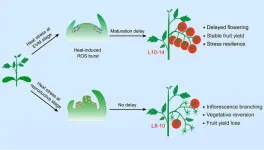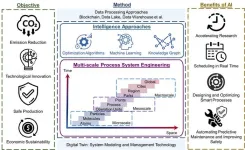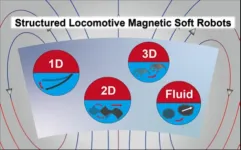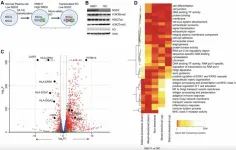(Press-News.org) Researchers have made a new discovery that changes our understanding of Earth’s early geological history, challenging beliefs about how our continents formed and when plate tectonics began.
A study published in Nature on 2 April reveals that Earth's first crust, formed about 4.5 billion years ago, probably had chemical features remarkably like today’s continental crust.
This suggests the distinctive chemical signature of our continents was established at the very beginning of Earth’s history.
Professor Emeritus Simon Turner from the Faculty of Science and Engineering at Macquarie University led the study, which included researchers from elsewhere in Australia, the UK and France.
“This discovery has major implications for how we think about Earth’s earliest history,” says Professor Turner.
"Scientists have long thought that tectonic plates needed to dive beneath each other to create the chemical fingerprint we see in continents.
“Our research shows this fingerprint existed in Earth’s very first crust, the protocrust – meaning those theories need to be reconsidered,” says Professor Turner.
Rethinking early Earth formation
For decades, scientists have tried to identify when plate tectonics first began, marking the earliest evolution of life.
The chemical signature of rocks formed in subduction zones (where one plate has slipped beneath another) is distinctive in its low quantity of the element Niobium.
Scientists thought finding the age of the earliest low-Niobium rocks was the key to identifying when plate tectonics first began; but while a series of research teams tried to track this down, the results from each study were remarkably inconsistent.
“I began to wonder if we were asking the right question,” says Professor Turner.
Together with collaborators across six universities, he created mathematical models simulating early Earth conditions when our planet’s core was forming and an ocean of molten rock covered the planet’s surface.
The team’s calculations showed the protocrust – Earth’s earliest crust formed during the Hadean eon (4.5-4.0 billion years ago) – would naturally develop the same chemical signatures found in today’s continents, without needing plate tectonics to create them.
Chemical clues to formation
The initial results from the model showed that under the reducing conditions of early Earth, the element niobium would become siderophilic, or attracted to metal, sinking through the global magma ocean into the Earth’s core.
“I realised there might be a connection between early core formation, high siderophile element patterns, and the infamous negative niobium anomaly observed in continental crust,” says Professor Turner.
The distinctive signature of the continental crust matched the probable signature of material extracted from the mantle after core formation but before meteorites bombarded early Earth – solving the mystery of why the chemical signature appears in nearly all continental rocks regardless of age.
Early Earth’s evolution
“Our research shows that the chemical signatures we see in continental crust were created in Earth’s earliest period - regardless of how the planet’s surface was behaving,” says Professor Turner.
“This early crust was reshaped and made richer in silica thanks to a combination of meteor impacts, chunks of crust peeling off, and the beginning of plate movements.”
The first crust likely broke into pieces that became thicker in some areas, forming the beginnings of continents.
As these pieces moved sideways, the molten magma between them created crust similar to what we find in ocean floors today.
Meteor impacts and plate tectonics
The heavy meteor bombardment during this early period caused extensive disruption and recycling of the crust.
Plate tectonics may have worked in fits and starts, triggered by meteor impacts until about 3.8 billion years ago, when meteor bombardment decreased dramatically as the early Solar System’s chaos gave way to more orderly orbits.
Plate tectonics then fell into a continuous, self-sustaining pattern.
“This discovery completely changes our understanding of Earth's earliest geological processes,” says Professor Turner.
“It also gives us a new way to think about how continents might form on other rocky planets across the universe.”
END
END
Early Earth's first crust composition discovery rewrites geological timeline
Modern continental rocks carry chemical signatures from the very start of our planet’s history, challenging current theories about plate tectonics.
2025-04-02
ELSE PRESS RELEASES FROM THIS DATE:
Dark diversity reveals global impoverishment of natural vegetation
2025-04-02
A study recently published in Nature indicates that human activities have a negative effect on the biodiversity of wildlife hundreds of kilometres away. A research collaboration led by the University of Tartu assessed the health of ecosystems worldwide, considering both the number of plant species found and the dark diversity – the missing ecologically suitable species.
For the study, over 200 researchers studied plants at nearly 5,500 sites in 119 regions worldwide, including all continents. At each site, they recorded all plant species on 100 m2 and identified the dark diversity – native species that could live there but were absent. ...
Study finds rates of breast and colorectal cancer screening nearly four-fold higher than lung cancer screening among those eligible
2025-04-02
Lung cancer screening has the potential to catch lung cancer early and save lives—but only if people get screened. Although lung cancer screening is recommended in the U.S. for certain individuals with a history of smoking, only 18% of eligible individuals in the U.S. get screened. One suggested explanation has been that those eligible are resistant to receiving preventive healthcare, but a new study published in JAMA and led by researchers at Mass General Brigham indicates otherwise.
Researchers from Mass General Brigham sought to investigate use of other preventive healthcare services among individuals eligible for lung cancer screening. ...
Sound frequencies of stars sing of our galaxy’s past and future
2025-04-02
A new study led by UNSW Sydney researchers into a cluster of stars 2700 light years away reveals their stages of evolution through the ‘sounds’ they make. This discovery will allow scientists to map the history of the Milky Way and other galaxies, accelerating knowledge in the field of astrophysics.
Dr Claudia Reyes is the lead author of the study published today in Nature. While undertaking her PhD at the UNSW School of Physics, she studied 27 stars in a cluster of stars called M67. The stars in ...
Tomato plants delay shoot meristem maturation to achieve heat-stress resilience
2025-04-02
As global temperatures continue to rise, extreme heatwaves pose a significant threat to agricultural productivity. Studies estimate that for every 1°C increase above pre-industrial levels, crop yields decline by approximately 6-8%. The ability of plants to withstand heat stress is therefore critical for ensuring food security, yet the underlying molecular mechanisms have largely remained elusive.
Now, however, a new study led by Prof. XU Cao's team at the Institute of Genetics and Developmental Biology (IGDB) of the Chinese Academy of Sciences sheds light on an adaptive strategy that may ...
KTU researchers explore using soil for heat storage
2025-04-02
When spring arrives and the heating season comes to an end, keeping warm becomes less of an issue. However, scientists remind us that it is not just a seasonal necessity – heat is also a valuable energy resource that can be stored and used when needed most. Researchers at Kaunas University of Technology (KTU) have discovered an innovative solution beneath our feet: using soil as an efficient thermal energy storage system.
KTU professor Dr Tadas Ždankus and his team have been investigating how the ground can serve not only for construction purposes but also as a medium for heat storage. At the ...
Sociology leaders rally in support of academia, urge protection of free inquiry and research
2025-04-02
The American Sociological Association has led a coalition of leading sociological organizations to issue an open letter defending the vital role of sociology in universities and society while condemning recent federal actions that threaten academic inquiry and free speech. Signed by the presidents of ten major sociological associations, the letter calls on university leaders, policymakers, and the public to resist efforts that undermine the discipline and stifle research that benefits society.
The signatories express their growing concerns over abruptly canceled federal contracts, looming job losses for sociologists ...
Exploring AI’s role in decarbonizing the chemical industry: A multi-scale perspective
2025-04-02
As the chemical industry seeks sustainable transformation, decarbonization requires intelligent solutions across multiple scales to enhance efficiency and reduce emissions. A research team led by Professor Xiaonan Wang at Tsinghua University has systematically reviewed AI-driven multi-scale smart systems for decarbonizing this energy-intensive sector. Published in Technology Review for Carbon Neutrality, the study explores innovations from materials discovery to industrial park optimization, highlighting ...
A review on structured magnetic soft robots: Locomotion innovation driven by structural engineering
2025-04-02
Recently, Dr. Renheng Bo, Research Associate Professor at the State Key Laboratory of Flexible Electronics Technology, Tsinghua University, and his colleagues published a new review article entitled "Structured Locomotive Magnetic Soft Robots" in Flextech. This article focuses on the relationship between structural configurations and locomotion modes of magnetic soft robots, which systematically summarizes the material compositions, fabrication methods, locomotion mechanisms, and applications of existing magnetic soft robots. Furthermore, it emphasizes current challenges and future research directions in the field of structured ...
NCCN 2025 Annual Conference illustrates the critical impact of cancer research on improving lives
2025-04-02
ORLANDO, FL [April 2, 2025] — The National Comprehensive Cancer Network® (NCCN®)—an alliance of leading cancer centers—celebrated 30 years of helping people with cancer to live better lives during the NCCN 2025 Annual Conference, March 28-30 in Orlando, Florida. The yearly event brings together leading minds and subject matter experts in front of a multidisciplinary audience to share the latest recommendations for cancer treatment and prevention.
“We are proud to honor our founders’ vision of sharing evidence-based, expert consensus-driven recommendations through clinical practice guidelines to improve ...
NSD2 gene drives cancer cell identity in multiple myeloma
2025-04-02
“Our findings suggest a role for NSD2 in maintaining MM cell identity, with potential implications for future therapeutic strategies based on targeting of NSD2.”
BUFFALO, NY – April 2, 2025 – A new research paper was published in Oncotarget, Volume 16, on March 21, 2025, titled “NSD2-epigenomic reprogramming and maintenance of plasma cell phenotype in t(4;14) myeloma.”
Researchers Andrea Gunnell, Scott T. Kimber, Richard Houlston, and Martin Kaiser from The Institute of Cancer Research, London, studied how a gene called ...
LAST 30 PRESS RELEASES:
Scalable and healable gradient textiles for multi‑scenario radiative cooling via bicomponent blow spinning
Research shows informed traders never let a good climate crisis go to waste
Intelligent XGBoost framework enhances asphalt pavement skid resistance assessment
Dual-function biomaterials for postoperative osteosarcoma: Tumor suppression and bone regeneration
New framework reveals where transport emissions concentrate in Singapore
NTP-enhanced lattice oxygen activation in Ce-Co catalysts for low-temperature soot combustion
Synergistic interface engineering in Cu-Zn-Ce catalysts for efficient CO2 hydrogenation to methanol
COVID-19 leaves a lasting mark on the human brain
Scientists use ultrasound to soften and treat cancer tumors without damaging healthy tissue
Community swimming program for Black youth boosts skills, sense of belonging, study finds
Specific depressive symptoms in midlife linked to increased dementia risk
An ‘illuminating’ design sheds light on cholesterol
Who is more likely to get long COVID?
Study showcases resilience and rapid growth of “living rocks”
Naval Research Lab diver earns Office of Naval Research 2025 Sailor of the Year
New Mayo-led study establishes practical definition for rapidly progressive dementia
Fossil fuel industry’s “climate false solutions” reinforce its power and aggravate environmental injustice
Researchers reveal bias in a widely used measure of algorithm performance
Alcohol causes cancer. A study from IOCB Prague confirms damage to DNA and shows how cells defend against it
Hidden viruses in wastewater treatment may shape public health risks, study finds
Unlock the power of nature: how biomass can transform climate mitigation
Biochar reshapes hidden soil microbes that capture carbon dioxide in farmland
Reducing saturated fat intake shows mortality benefit, but only in high-risk individuals
Manta rays create mobile ecosystems, study finds
Study: Mixed results in using lipoic acid to treat progressive multiple sclerosis
Norbert Holtkamp appointed director of Fermi National Accelerator Laboratory
New agentic AI platform accelerates advanced optics design
Biologists discover neurons use physical signals — not electricity — to stabilize communication
Researchers discover that a hormone can access the brain by hitchhiking
University of Oklahoma researcher awarded funding to pursue AI-powered material design
[Press-News.org] Early Earth's first crust composition discovery rewrites geological timelineModern continental rocks carry chemical signatures from the very start of our planet’s history, challenging current theories about plate tectonics.






